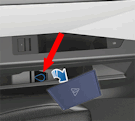Rear radar system These are Rear Radar System Indicators symbols from Volvo. A green indicator simply means that the system is active and working normally. If, however, there is a fault with the rear radar system, the red symbol will appear. A flashing symbol means there is a calibration failure. Before continuing, is one of …
Category: Articles & Commentaries
Discussions on topics of interest to drivers concerning things they may not understand about their vehicles as well as articles on the future of the auto industry.
Permanent link to this article: https://dashboardsymbols.com/2025/10/a-possible-safety-risk-we-all-need-to-know-about/
Permanent link to this article: https://dashboardsymbols.com/2025/10/rear-radar-system-indicators/
Electric Vehicle Jump Start Videos
Electric Vehicle Jump Start What follows is the series of videos we’ve been putting together to help with electric vehicle jump start procedures if the vehicle’s 12-volt start battery dies. It is not widely known that every EV features a 12-volt battery that essentially runs everything except the electric motor(s). The high-voltage battery handles that, …
Permanent link to this article: https://dashboardsymbols.com/2025/10/electric-vehicle-jump-start-videos/
Cybertruck fire deaths prompt a re-write of our Get Out page
Get Out page The recent announcement of lawsuits over the deaths of two college students in a Cybertruck fire has us rethinking and re-writing out Get Out page. We believe we were first to call attention to electronic locks and latches some ten years ago with the death a man in the hot Texas sun …
Permanent link to this article: https://dashboardsymbols.com/2025/10/cybertruck-fire-deaths-prompt-a-re-write-of-our-get-out-page/
So AAA asks, “What’s the Story With Headlight Glare?” Good question…
Headlight glare It used to be if an approaching vehicle’s headlights were on the bright setting, it was nearly always readily apparent. Now headlight glare seems to be an epidemic. Well, the AAA article I just saw was marginally helpful, noting among other things that today’s LED (light emitting diode) lamps produce a bluer light …
Permanent link to this article: https://dashboardsymbols.com/2025/10/so-aaa-asks-whats-the-story-with-headlight-glare-good-question/
Colorado counters loss of Federal EV incentives with possibly a big waste of taxpayer dollars
EV incentives Colorado is evidently intent on electrifying the fleet of its citizens automobiles. October 1st marked the end of Federal EV incentives, but the Rocky Mountain State countered by raising its own purchasing incentives to as much as $9,000, $1,500 more than the cancelled bonus. As reported by InsideEVs, a credit on used EVs …
Permanent link to this article: https://dashboardsymbols.com/2025/10/colorado-counters-loss-of-federal-ev-incentives-with-possibly-a-big-waste-of-taxpayer-dollars/
Lawsuit claims two are dead due to flawed electronic door designs
Flawed electronic door The electronic lock and latch beat goes on. The parents of Krysta Tsukahara and Jack Nelson have filed lawsuits against Tesla claiming that flawed electronic door designs are responsible for the deaths of the two college students in a burning Cybertruck. The suits, filed in Alameda County Superior Court, Alameda, CA, are …
Permanent link to this article: https://dashboardsymbols.com/2025/10/lawsuit-claims-two-are-dead-due-to-flawed-electronic-door-designs/




A possible safety risk we all need to know about
Safety risk I happened on a video out of Idaho that pointed out a potentially serious safety risk to drivers. The tempered glass used in side windows is easily shattered so that an occupant can easily escape. The glass in a windshield has an added layer of plastic between two layers of glass so that …
Continue reading